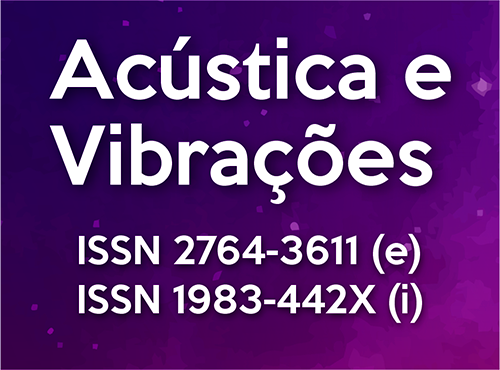Avaliação sonora de espaços urbanos na área central de São Paulo: o caso da Avenida Ipiranga
DOI:
https://doi.org/10.55753/aev.v34e51.78Palavras-chave:
avaliação sonora, paisagem sonora, acústica urbana, mapa de ruído, poluição sonoraResumo
Visto o momento atual em que planejadores urbanos incentivam fortemente a tomada de medidas institucionais para favorecer a ocupação da região central da cidade de São Paulo, o presente trabalho procura analisar quais as reais condições de ruído às quais estão sujeitas as populações que lá habitam. Foi realizada uma avaliação sonora em pontos estratégicos da região central do município de São Paulo, considerando aspectos quantitativos e qualitativos. Foram considerados diferentes perfis de uso e ocupação, altura dos edifícios, densidade construtiva, quantidade de espaços vazios, largura das vias e capacidade de fluxo de veículos. Além das medições acústicas, foram avaliados o perfil e o fluxo dos veículos, para servir como dado de entrada para simulação em modelo computacional do ruído ambiental urbano e elaboração de mapas de ruído das áreas selecionadas. O conceito de paisagem sonora foi abordado com a caracterização das fontes sonoras locais e sua percepção sonora. Foram aplicados questionários para avaliação subjetiva e o perfil dos entrevistados também foi caracterizado. Essa atitude é importante, pois leva a um entendimento de quem exatamente está exposto e é afetado por determinados níveis sonoros, e como um mesmo nível sonoro pode gerar percepções diferentes. Essa sensibilidade na abordagem do tema faz com que as pessoas deixem de ser apenas números e estratégias mais humanas sejam adotadas para o planejamento urbano. Ao final, foi produzida uma imagem para resumir a análise global realizada. O presente estudo auxilia na compreensão sobre os problemas acústicos de áreas da cidade visadas para adensamento.
Referências
BABISCH W. The noise/stress concept, risk assessment and research needs. Noise & Health; Volume 4, Issue 16, pp 1-11, 2002. Disponível em: https://pubmed.ncbi.nlm.nih.gov/12537836/
KANG, J.; SCHULTE-FORTKAMP, B. Soundscape and the Built Environment. 1. Ed., CRC Press, 2017. ISBN 9781138893085. doi: 10.1201/b19145 DOI: https://doi.org/10.1201/b19145
WORLD HEALTH ORGANIZATION. Guidelines for Community Noise. 1999. Disponível em: http://whqlibdoc.who.int/hq/1999/a68672.pdf.
BARING, J. G. de A. Controle da Poluição Sonora: planejamento de pesquisas nas universidades brasileiras, tendo em vista a experiência da cidade de São Paulo. In: XXII Encontro da Sociedade Brasileira de Acústica, SOBRAC 2008. Belo Horizonte, MG, 2008.
SÃO PAULO (Município). Lei Nº 8.106, de 30/09/1974, Sons urbanos, São Paulo, 1994. 6. SÃO PAULO (Município). Decreto Nº 11.467, de 30/10/1974. Regulamenta a lei 8106 de 30/09/1974, que dispõe de sons urbanos, São Paulo, 1994.
BRASIL. Ministério do Trabalho. Portaria Nº 3.214, de 08/06/78 – NR 15 – Anexos 1 e 2. Limites de nível de ruído nos ambientes de trabalho, Brasília, 1978.
BRASIL. CONAMA (Conselho Nacional do Meio Ambiente). Resolução Nº 1, de 08/03/90: Emissão de ruídos. Brasília, 1990.
BRASIL. CONAMA (Conselho Nacional do Meio Ambiente). Resolução Nº 2, de 08/03/90: Programa Nacional de Educação e Controle da Poluição Sonora – Silêncio. Brasília, 1990.
SÃO PAULO (Município). Decreto-lei Nº 11.501, de 11/04/1994. Controle e a fiscalização das atividades que gerem poluição sonora, São Paulo, 1994.
SÃO PAULO (Município). Decreto-lei Nº 34.569, de 6/10/1994. Programa Silêncio Urbano - PSIU, São Paulo, 1994.
SÃO PAULO (Município). Lei Nº 16.402, de 22/03/2016. Lei de Parcelamento, Uso e Ocupação do Solo de São Paulo. São Paulo, SP, 2016.
SÃO PAULO (Município). Decreto-lei Nº 16.499, de 20/06/2016. Elaboração do Mapa do Ruído Urbano da Cidade de São Paulo e dá outras providências. Diário Oficial do Município de São Paulo. São Paulo, SP, 20 jul. 2016.
HOLTZ, M. C. de B., Avaliação qualitativa da paisagem sonora de parques urbanos. Estudo de caso: Parque Villa Lobos, em São Paulo. Dissertação (Mestrado) — Faculdade de Arquitetura e Urbanismo, Universidade de São Paulo, São Paulo, 2012. doi: 10.11606/D.16.2012.tde-02072012-143458 DOI: https://doi.org/10.11606/D.16.2012.tde-02072012-143458
CORTÊS, M. M. Método de avaliação sonora em áreas urbanas formais e informais. Tese (Doutorado) — Faculdade de Arquitetura e Urbanismo, Universidade Federal do Rio de Janeiro, Rio de Janeiro, 2018. Disponível em: https://proarq.fau.ufrj.br/teses-e-dissertacoes/971/metodo-de-avaliacao-sonora-em-areas-urbanas-formais-e-informais
MARIE CURIE ACTIONS. Urban Sound Planning: The SONORUS project. Chalmers University of Technology, Suécia, 2016. Disponível em: https://publications.lib.chalmers.se/records/fulltext/242257/local_242257.pdf
HONG, J.; JEON, J. Y. Relationship between spatiotemporal variability of soundscape and urban morphology in a multifunctional urban area: A case study in Seoul, Korea. Building and Environment. v. 126, p. 382 – 395, 2017. Disponível em: doi: 10.1016/j.buildenv.2017.10.021. DOI: https://doi.org/10.1016/j.buildenv.2017.10.021
ISO (International Organization for Standardization). ISO 12913-1. Acoustics – Soundscape – Part 1: Definition and conceptual frameworks, Genebra, 2014.
ISO (International Organization for Standardization). ISO/TS 12913-2. Acoustics – Soundscape – Part 1: Data collection and reporting requirements, Genebra, 2018.
ISO (International Organization for Standardization). ISO/TS 12913-3. Acoustics – Soundscape – Part 1: Data analysis, Genebra, 2019.
ABNT (Associação Brasileira de Normas Técnicas). ABNT NBR 10151, Acústica – Medição e avaliação de níveis de pressão sonora em áreas habitadas – Aplicação de uso geral. Rio de Janeiro, 2019.
DATAKUSTIK. CadnaA software. Disponível em: http://www.datakustik.com/en/products/cadnaa. Acesso em: 20 out. 2019.
GEOSAMPA, Mapa Digital da Cidade de São Paulo. Disponível em: http://geosampa.prefeitura.sp.gov.br. Acesso em: 10 jul. 2019.
ISO (International Organization for Standardization). ISO 80000-8. Quantities and units - Part 8: Acoustics, Genebra, 2007.
ABNT (Associação Brasileira de Normas Técnicas). ABNT NBR 16313, Acústica – Terminologia. Rio de Janeiro, 2014.
BISTAFA, S. R. Acústica aplicada ao controle do ruído. São Paulo: Blucher, 2006. ISBN 9788521212836.
YANG, W.; KANG, J. Soundscape and Sound Preferences in Urban Squares: A Case Study in Sheffield. Journal of Urban Design, v. 10, no. 1, p. 61 – 80, 2005. doi: 10.1080/13574800500062395 DOI: https://doi.org/10.1080/13574800500062395

Downloads
Publicado
Como Citar
Edição
Seção
Licença
Copyright (c) 2019 Acústica e Vibrações

Este trabalho está licenciado sob uma licença Creative Commons Attribution-NonCommercial-ShareAlike 4.0 International License.




